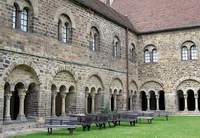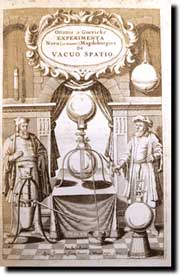| | | | | | | | | |
|
|
|
|
|
| Otto
von
Guericke |
|
| Magdeburg
20.November.1602-Hamburg
11.May.1686 |
|
|
| |
|
|
|
Biographical notes
|
|
|
| |
| |
| Edited
by L'
Istituto
e Museo di Storia della Scienza, Firenze, Italia
|
|
|
|
|
|
| Descendant of a
wealthy family of Magdeburgo, studied law to the university of
Lipsia (1617-1620), Helmstedt (1620) and Jena (1621-1622), in order
then to o to Leida, where, beside the legal studies, she attended
mathematics course and she began to take care itself of engineering
problems. After to have covered various governmental functions in its
city born them, in 1631, he moved himself to Erfurt, in order to work
like engineer for the Swedish government, passing, therefore, in 1635,
to the service of the Constituent of Sassonia. In the years
between
1646 and 1676, held the charge of mayor of Magdeburgo. Although its
time widely was absorbed from the public life and from the relative
burdens, von Guericke continued, however, to take care itself of
science experiences them, and came soon to acquaintance of the new
connected developments of the physical debate to the innovative
Cartesian theories and the barometric experiments of Torricelli. In
order to put to the test “the pleniste” theses
(that they denied the
existence of the empty one) of Descartes, von Guerické
devised and
realized - also between many failures - various models of pumps in
order to produce the empty one. In the same years, it was engaged also
to repeat the barometric experiments and to study to bottom the problem
of the pressure of the air. It is within these interests
that, in
1657, von Guericke realized its more famous experiment. Two semisphere
ones of bronze of approximately 50 cm. of diameter perfectly
superimposed came joined one to the other after that, to their inside,
it had been produced the empty one by means of a pneumatic pump.
Incredibly, in order to separate the two members it was necessary the
combined force of two couples of 8 horses, that they pulled in
directions opposed. evocative experiment,
initially described
in the hydraulic-pneumatic Mechanical of Gaspar Schott (1657) and then
spectacularly repeated in front of the Berliner court in 1663, served
to confirm the torricelliane discoveries and to evidence the amazing
effects of the atmospheric pressure. of
Lipsia (1617-1620), Helmstedt (1620) and Jena (1621-1622), in order
then to o to Leida, where, beside the legal studies, she attended
mathematics course and she began to take care itself of engineering
problems. After to have covered various governmental functions in its
city born them, in 1631, he moved himself to Erfurt, in order to work
like engineer for the Swedish government, passing, therefore, in 1635,
to the service of the Constituent of Sassonia. In the years
between
1646 and 1676, held the charge of mayor of Magdeburgo. Although its
time widely was absorbed from the public life and from the relative
burdens, von Guericke continued, however, to take care itself of
science experiences them, and came soon to acquaintance of the new
connected developments of the physical debate to the innovative
Cartesian theories and the barometric experiments of Torricelli. In
order to put to the test “the pleniste” theses
(that they denied the
existence of the empty one) of Descartes, von Guerické
devised and
realized - also between many failures - various models of pumps in
order to produce the empty one. In the same years, it was engaged also
to repeat the barometric experiments and to study to bottom the problem
of the pressure of the air. It is within these interests
that, in
1657, von Guericke realized its more famous experiment. Two semisphere
ones of bronze of approximately 50 cm. of diameter perfectly
superimposed came joined one to the other after that, to their inside,
it had been produced the empty one by means of a pneumatic pump.
Incredibly, in order to separate the two members it was necessary the
combined force of two couples of 8 horses, that they pulled in
directions opposed. evocative experiment,
initially described
in the hydraulic-pneumatic Mechanical of Gaspar Schott (1657) and then
spectacularly repeated in front of the Berliner court in 1663, served
to confirm the torricelliane discoveries and to evidence the amazing
effects of the atmospheric pressure.
|
|
|
|
|
|
|
|  |
|
| Experimenta Nova (ut vocantur)
Magdegurgica de Vacuo
Spatio Otto vonGuericke 1672
|
|
|
|---|
